The Philae Temple: An Unmissable Sight in Egypt
Egypt is, without a doubt, one of the most enchanting countries to explore, with its ancient temples steeped in mystery and captivating the attention of every traveller. Among the many unique sights scattered across the land, one is an unmissable attraction: the Philae Temple.
With towering hieroglyph-embossed walls narrating the story of ancient Egypt's mystique and beauty, it is no surprise that this temple has captured the imagination of countless travellers over the years. If you plan a trip to this remarkable land, add the Philae Temple to your itinerary for an unforgettable experience.
Join us as we delve into the fascinating history and breathtaking features of one of Egypt's most captivating temples, and discover what makes the Philae Temple an unmissable sight.
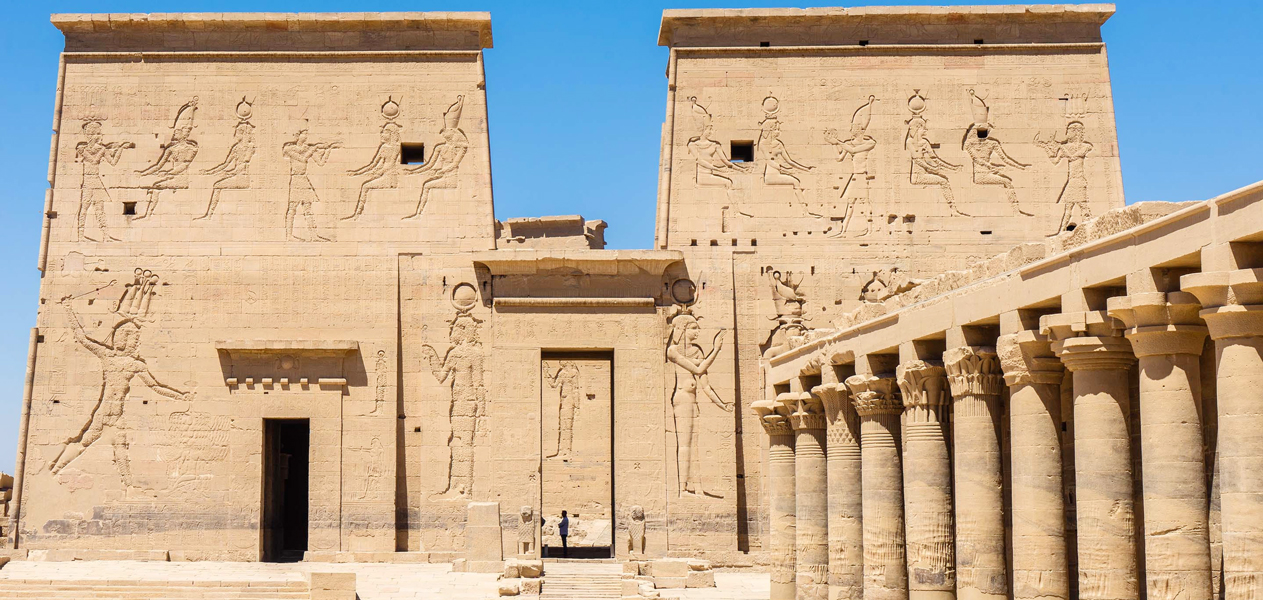
A brief overview of Philae Temple
The Philae Temple, an astounding sight in Egypt's Aswan region, is considered one of the country's most beautiful temples. With its towering hieroglyph-embossed walls, this stunning temple complex is dedicated to several deities and pharaohs, boasting an array of temples, chapels, and shrines.
Among the grandiosity and exquisite craftsmanship of the temple lies an intriguing aspect of ancient Egyptian mythology. The temple honours the goddess Isis, the god Horus, and Osiris. Erected during the Ptolemaic Dynasty, the primary structure - the Isis temple - is a striking building adorned with giant reliefs. Philae Temple is said to be the last temple constructed in the classical Egyptian style.
The temple complex serves as a haven of tribute for ancient Egypt, showcasing the confluence of Egyptian and Greek cultures during this fascinating period. Philae’s sanctuaries include the Temple of Horus, the chapels of Imhotep, and the Nubian god Mandulis. The site also has several kiosks and beds, like the Trajan and Nectanebo.
Philae Temple is unmissable, boasting architectural marvels like the Arch of Hadrian. It is a must-visit spot in Egypt for anyone interested in exploring the legacy of ancient Egyptian civilization. [1][2]
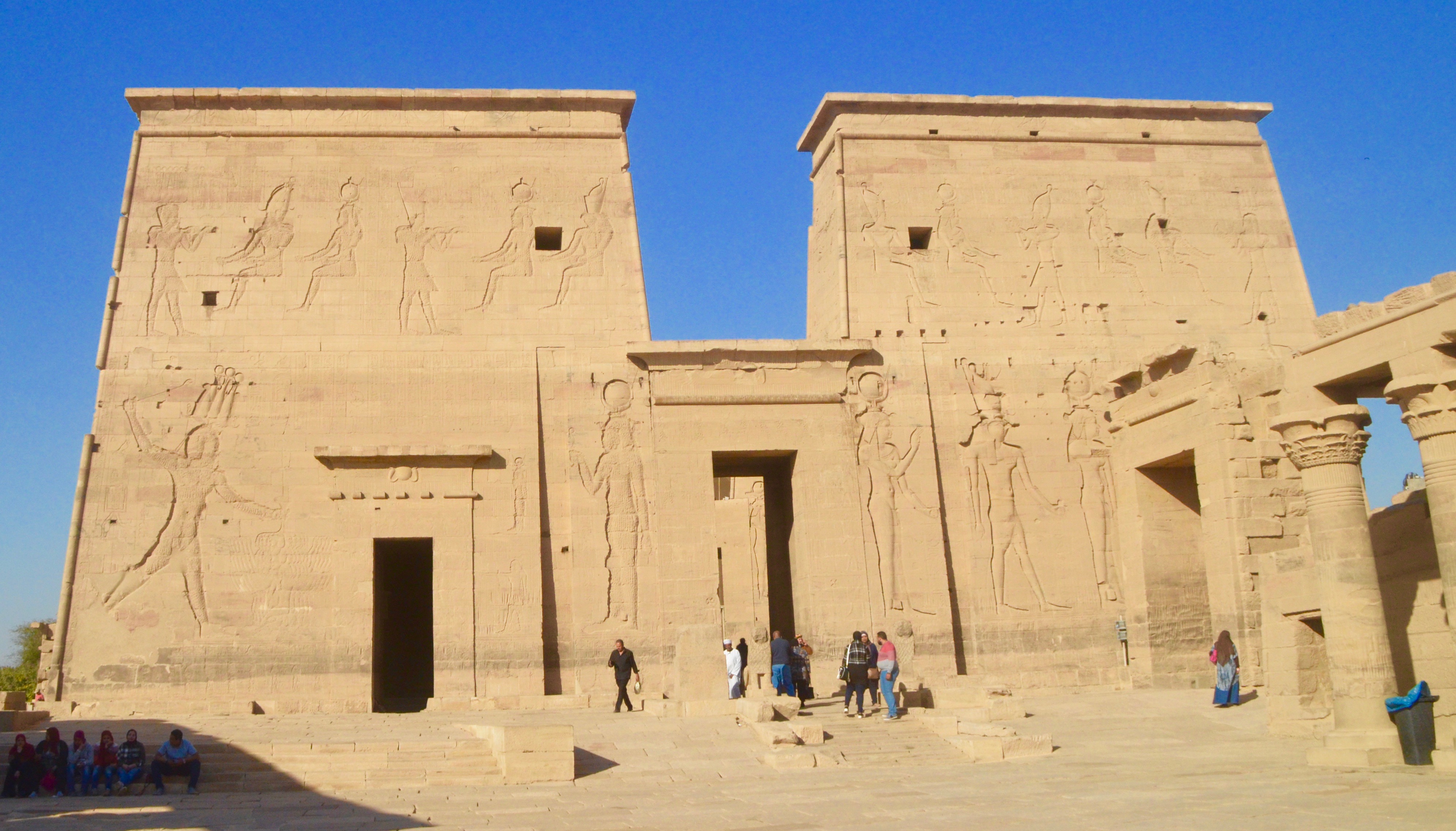
Importance of visiting the temple
Philae Temple is a significant monument that holds great importance in Egypt's rich history and culture. Visiting this magnificent temple offers an unforgettable experience that tourists should not miss. The temple's unique architectural style blends Greek and Egyptian elements, leaving visitors in awe of its beauty. The temple walls are adorned with epic scenes and countless hieroglyphs, showcasing Egyptian mythology with the goddess Isis as the main protagonist.
The temple complex offers a surreal view of the mighty Nile and a few amazing quiet spots away from the crowd. Visitors can sit, forget everything else, and watch the Nile flow by. The eastern Trajan's Kiosk, which used to be the actual entrance to the temple, is also a must-see attraction. It survived through the Pharaonic, Greek, and Byzantine eras, standing out as a true testament to the resilience of ancient Egyptian architecture.
Visiting the Philae Temple is an enriching experience that embodies ancient Egypt's history, culture, and art. It offers a unique opportunity to learn about the power of one of the most worshipped and revered goddesses in Egyptian mythology while immersing oneself in the country's rich cultural heritage. [3][4]
Location and background information
Located on the picturesque island of Agilika, just south of the old Aswan Dam, Philae Temple is considered one of Egypt's most stunning temples. With a turbulent history at the crossroads of the rise and fall of three great empires, this temple is a testament to its time.
Initially built during the Ptolemaic Kingdom, construction continued throughout the Roman period, blending different architectural styles. Philae Temple became the centre of the Egyptian mythos during the Saite period when it sought to please the Egyptians by dedicating the temple to their beloved gods and goddesses.
The temple complex features several shrines, chapels, and sanctuaries, each honouring a different deity or pharaoh. Notably, it was the last to use the classical Egyptian style and boasts the final hieroglyphic texts written in ancient Egypt.
To protect the temple from the waters of the newer Aswan Dam, the complex was carefully relocated to a nearby island and restored to its former glory. Today, visitors can explore the island of Philae, beginning with the monumental facade of the temple. They can then pass through courtyards, marvelling at the darkened core of the temple complex adorned with intricate hieroglyphs.
With its architectural beauty and historical significance, Philae Temple is a must-visit site for any traveller exploring Egypt. [5][6]
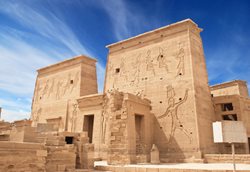
An array of temples, chapels, and shrines
One of the highlights of visiting the Philae Temple is the array of temples, chapels, and shrines dedicated to several deities and pharaohs. The complex serves as a haven of tribute, boasting a richly diverse collection of structures, each with its unique story and history. Visitors will be amazed by the sheer scale and grandeur of the temples, colonnades, kiosks, and sanctuaries that rise against the skyline.
The principal structures are located at the south end of the smaller island and date back to the time of the Pharaohs and the Caesars. The most ancient temple, built during the reign of Nekhtnebef for Amun of Karnak, is approached from the river through a double portal. For the most part, the other ruins date from the Ptolemaic Kingdom.
In front of the propyla stand two colossal statues of Ramses II. The propyla themselves are pyramidal in form and colossal in dimensions. Beyond the entrance, the principal court houses small temples, one dedicated to Isis Hathor and a wide range of related deities. These temples are adorned with sculptures representing the birth of Ptolemy Philometor under the figure of the god Harpocrates.
The Philae Temple complex is one of the most impressive and extensive in Egypt, serving as a testament to the country's rich cultural and historical heritage. [7][8]

Honoring different deities and pharaohs
The Philae Temple is a treasure trove of history and stunning architecture. One of its most notable features is the honour bestowed upon different deities and pharaohs. The Ptolemies, who sought to win the favour of Egyptians, constructed numerous temples dedicated to their most beloved gods and goddesses, including the Temple of Isis at Philae. The main temple and smaller temples and shrines on the island are dedicated to various deities and pharaohs, such as Osiris, Horus, and Imhotep. The temple is also home to a small temple to the god of medicinal healing, who was once a builder of Djoser's pyramid, and temples dedicated to two Nubian deities.
Isis, a prominent deity worshipped by both Egyptians and Nubians, takes pride of place at the temple. Legends about her magical powers and divine knowledge draw countless visitors to the island, where priests, notably clad in white vestments, claim to know the mysteries of Isis. It is during the spring and autumn festivals that visitors can view the image of the goddess. At these festivals, the death and resurrection of Osiris are reenacted, with Isis playing a crucial role. Her tears are believed to cause the annual flood that brought life to the land.
The honouring of different deities and pharaohs at Philae Temple showcases the diversity of Egyptian religious beliefs and practices and the temple's rich history and cultural significance. It is truly an unmissable sight in Egypt, a testament to the enduring legacy of the ancient civilization and their devotion to their gods. [9][10]
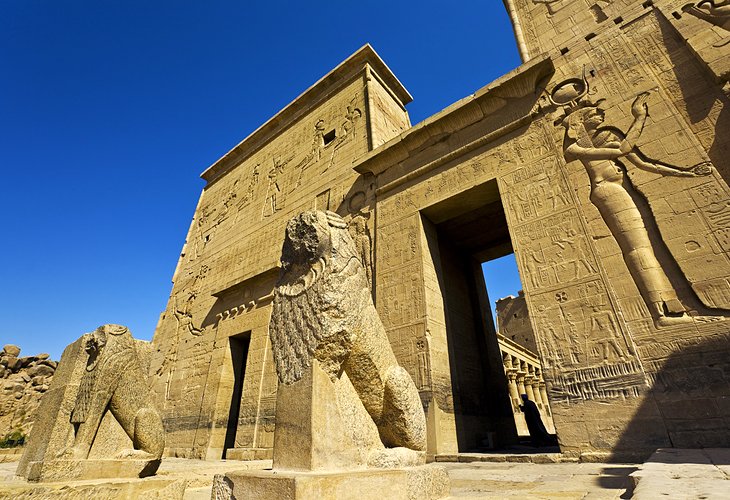
Entrance and main temple area
As you approach the entrance to the Philae Temple, you'll be greeted by the First Pylon, an 18-meter-high monumental gateway decorated with incredible reliefs. To reach the main temple area, you'll pass through this grand entryway, flanked by towering pylons on either side. This awe-inspiring sight sets the tone for the rest of your visit.
Once you've made your way through the First Pylon, you'll find yourself in the heart of the temple complex. The main temple area is centred around the Temple of Isis, the most striking building on the island. Erected during the time of Ptolemy II, this beautiful structure is carved with giant reliefs and was initially intended to worship Isis. However, Horus and Osiris were also worshipped here. Filled with intricate artwork and architectural marvels, the Temple of Isis provides ample opportunity for exploration.
Another highlight of the main temple area is the Arch of Hadrian, a magnificent ornamental gateway built during the Roman period. This breathtaking sight is truly a must-see.
A visit to the entrance and main temple area of the Philae Temple is an unforgettable experience that you won't want to miss when in Egypt. [11][12]

Arch of Hadrian and other significant sanctuaries
The Arch of Hadrian should not be missed among the significant sanctuaries found in the Philae Temple complex. This beautiful archway was built in honour of Emperor Hadrian, who visited the temple during his travels to Egypt in the second century AD. The ornately decorated arch is a stunning example of classical architecture, and its detailed carvings of gods and goddesses are truly remarkable.
Other notable sanctuaries in the temple include the Temple of Hathor, dedicated to the goddess of love and beauty, and the Kiosk of Nectanebo I, which honours the goddess Isis. The Temple of Imhotep was dedicated to the famous architect and chancellor of King Djoser. At the same time, the Gate of Philadelphus was built under the reign of Ptolemy II to connect the northern colonnade with the rest of the temple complex.
These structures demonstrate the incredible attention to detail and artistic flair that characterized ancient Egyptian architecture. Whether you are a history buff or appreciate beautiful design, the Philae Temple complex is not to be missed. The Arch of Hadrian and other stunning sanctuaries will leave a lasting impression on visitors. [13][14]
Artworks and architectural marvels
One of the most awe-inspiring aspects of the Philae Temple is the incredible array of artworks and architectural marvels found within the complex. From the hieroglyphic reliefs adorning the walls to the towering columns and intricate carvings, every inch of the temple is a testament to the incredible skill of the ancient Egyptian craftsmen.
Visitors can marvel at the stunning Arch of Hadrian, admire the intricate detail of the various shrines and chapels, and stand in wonder before the main temple area. The artwork found within Philae Temple is also noteworthy, with beautiful depictions of gods and goddesses and scenes from ancient Egyptian mythology gracing the walls.
And it's not just the impressive artwork - the sheer scale of the temple, with towering columns and massive structures, is a marvel of ancient engineering. As they leave Philae Temple, visitors will be in awe of the skill and creativity of the ancient Egyptians. They will gain a newfound appreciation for the beauty and complexity of their culture. [15][16]

Construction during the reign of Ptolemy II
The Philae Temple boasts a rich history dating back to the reign of Ptolemy II, who constructed this splendid temple in honour of his wife Arsinoe II, a goddess. Dedicated to Isis, Hathor, and Osiris, it took over a century to complete this architectural marvel. Regarded as an exceptional example of classical Egyptian style, the temple complex displays impeccable workmanship and architectural brilliance.
Comprising several temples, shrines, and chapels, the Philae Temple dedicates each structure to different deities and pharaohs. As one of the last temples to incorporate the classical Egyptian style, its unique features make it a must-see destination for visitors to Egypt. Not only is the temple an architectural spectacle, but it also holds great significance within ancient Egyptian mythology.
The walls of the temple depict scenes from Egyptian mythologies, including the story of Isis bringing Osiris back to life, giving birth to Horus, and mummifying Osiris after his death. In summary, the Philae Temple is an architectural and mythological masterpiece that offers visitors a glimpse into the rich and diverse culture of ancient Egypt. [17][18]
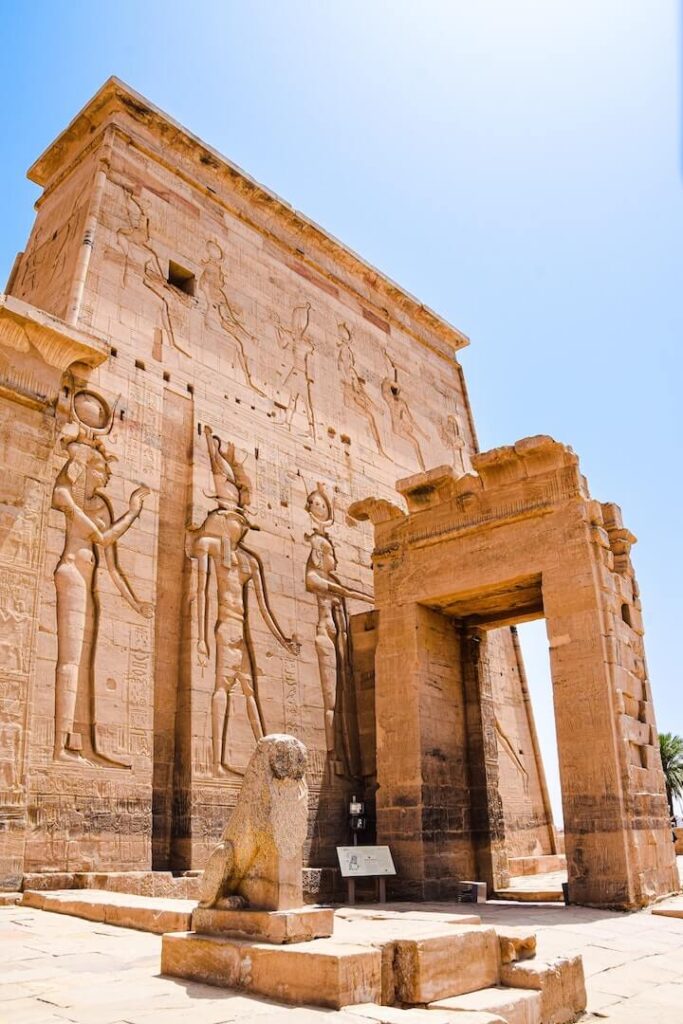
Last temple to use classical Egyptian style
The Philae Temple is truly a remarkable sight to behold, boasting an array of temples, chapels, and shrines that honour various deities and pharaohs. As one of the most important Ancient Egyptian temples, it represents the last structure to utilize the classical Egyptian style. Constructed during the reign of Ptolemy II in the 3rd century BC on the island of Philae in the Nile River, the temple was continually expanded and enhanced over the centuries.
Serving as a testament to the incredible achievements of the Ancient Egyptians and their mastery of architecture and design, the Philae Temple's grand entrance and main temple area are genuinely awe-inspiring. The intricate details and symbolism of the Arch of Hadrian and other significant sanctuaries add to the site's splendour.
Artworks and architectural marvels throughout the temple bring to life the fascinating stories and myths of Ancient Egypt. A visit to Philae Temple offers an unforgettable experience, with its grandeur and majesty transporting visitors to a time long past. No wonder thousands of tourists flock to the temple each year, eager to immerse themselves in its rich history and marvel at the impressive structures. [19][20]
